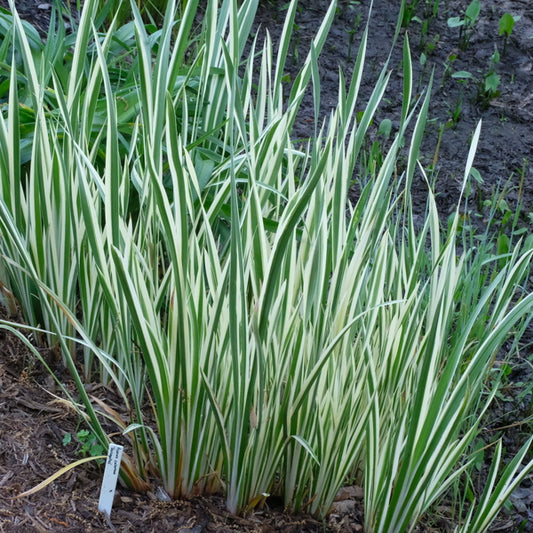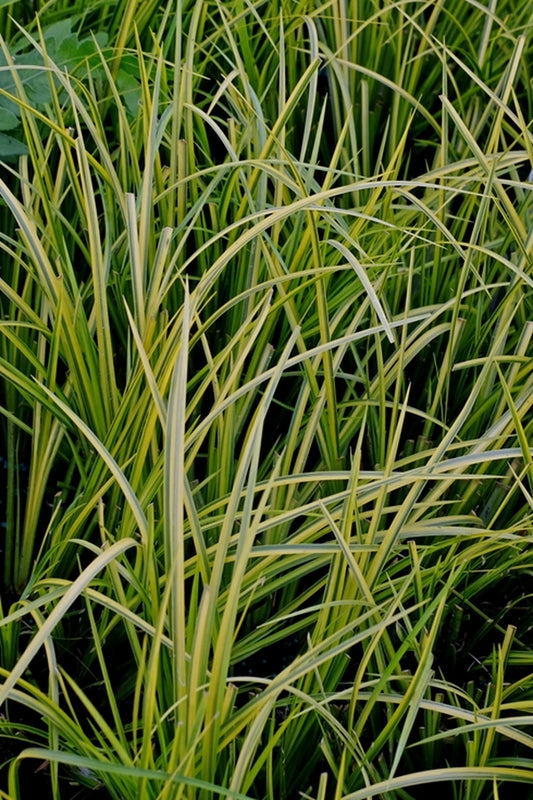The genus Acorus has three species, the deciduous Acorus americanus (native to the US), Acorus calamus (Europe) and the evergreen Acorus gramineus (Asia). All are used as herbal medicine and are frequently called Calamus.
-
Acorus calamus 'Variegatus'
Item #: 767
Zones: 4a to 9b
Dormancy: Winter
Height: 36" tall
Culture: Sun to Part Sun
Origin: Europe
Pot Size: 3.5" pot (24 fl. oz/0.7 L)
Regular price $24.00Regular priceUnit price per -
Acorus gramineus 'Ogon'
Item #: 369
Zones: 5a to 9b
Dormancy: Evergreen
Height: 12" tall
Culture: Part Sun to Light Shade
Origin: China, Japan
Pot Size: 3.5" pot (24 fl. oz/0.7 L)
Regular price $22.00Regular priceUnit price per
More Information About Acorus
The genus Acorus has three species, the deciduous Acorus americanus (native to the US), Acorus calamus (Europe) and the evergreen Acorus gramineus (Asia) and all of them can be known by the common name calamus. Sweet flag is best used as an accent plant in moist woodland gardens or as a bog plant, where the exotic colors of yellow and variegated cultivars (like Acorus calamus 'Variegatus' or Acorus gramineus 'Ogon') are great in both summer and winter.
The subtle charm of the gold or variegated forms of Acorus gramineus improves with age, as they blend effectively with a wide array of woodland and bog plants. Although ornamental grass -like in appearance, acorus plants are not true ornamental grasses, but are in a family of their own (acoraceae) that is closely related to aroids. Gardeners can use sweet flag as they would an ornamental grass or iris in a shady or part sun area with average to high soil moisture. They are tough, low maintenance plants which makes them perfect for rain gardens.
The genus Acorus was recently determined to be the oldest and most primitive monocot genus . If you want to know what the first monocots looked like over 130 million years ago, look at a sweet flag today.
On the ethnobotany side, Sweet flag plants have long been used by Native Americans as an antibiotic, insecticide and to ease stomach and intestinal issues. The calamus root is also said to act as a stimulant and mild psychedelic. Far out! Acorus leaves are fragrant and when cut up can scent clothes and cupboards and at the same time repel insects. The leaves have a vanilla-like flavor and can be used in tea. So sweet flag is sweet on the stomach! Sweet flag's fragrant and bitter rhizome has also been used to flavor tea, candy and medicines and it is a good substitute for cinnamon, ginger, or nutmeg.
Sweet flag flowers are similar to calla lilies or peace lilies, only they are naked (no spathe - just a spadix). This immodest floral display led poet Walt Whitman to write his 'Calamus poems' in the 1860 work 'Leaves of Grass', using the flower is a symbol of 'manly love'. Whitman was also said to enjoy chewing the root to energize him on long walks. Henry David Thoreau also enjoyed sweet flag and described it as he walked near Walden Pond. We believe that you'll Thoreau-ly love the deer-resistant acorus too. Let your sweet flag fly in the garden today and grow acres of acorus! It is worth noting that Acorus americanus is also a North Carolina native plant.



